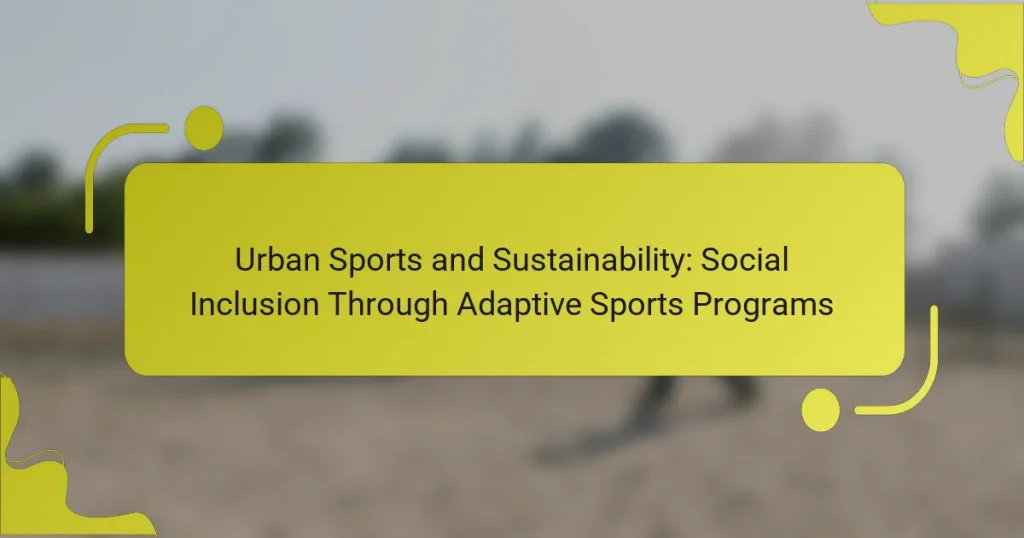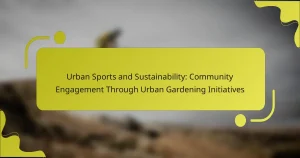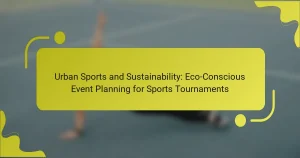Urban sports play a crucial role in promoting social inclusion and sustainability through adaptive sports programmes. These initiatives foster community engagement, enhance accessibility for individuals with disabilities, and contribute to environmental awareness. By transforming urban spaces into inclusive hubs, they encourage diverse participation and improve overall community cohesion. Key organisations like the International Paralympic Committee and Special Olympics lead these efforts, ensuring that adaptive sports programmes are effective and impactful.
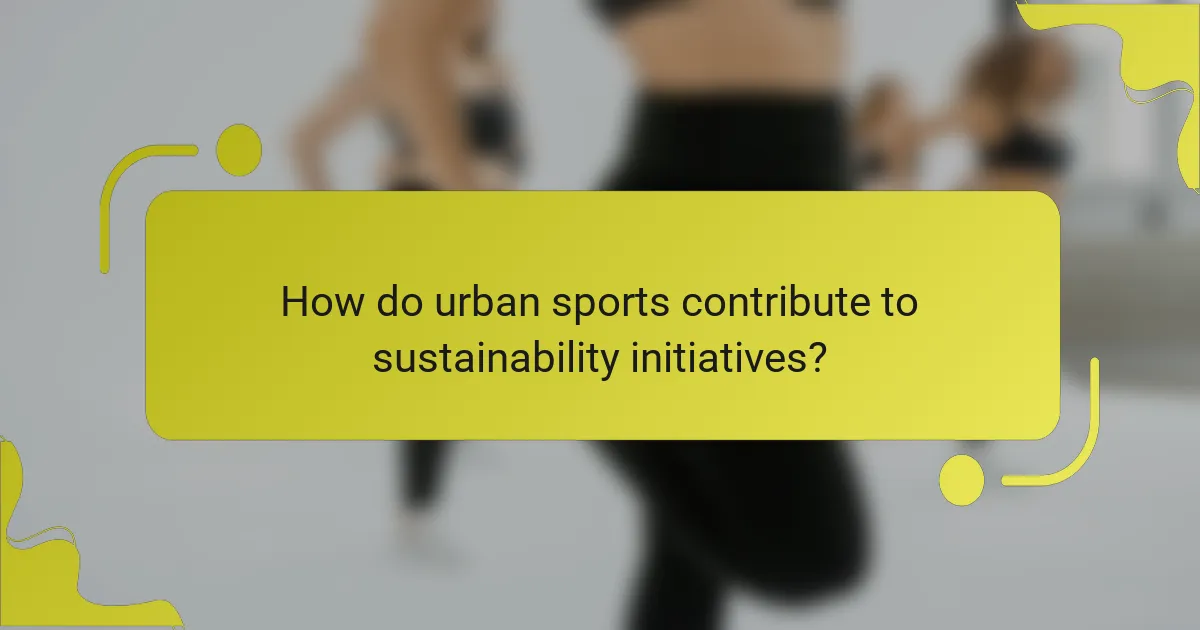
How do urban sports contribute to sustainability initiatives?
Urban sports significantly contribute to sustainability initiatives by promoting social inclusion through adaptive sports programmes. These programmes engage diverse communities, fostering environmental awareness and encouraging active participation in urban spaces.
For example, urban skate parks and BMX tracks can transform neglected areas into vibrant community hubs, reducing urban blight. As a result, these initiatives often lead to improved green spaces and reduced carbon footprints.
Moreover, adaptive sports programmes ensure that individuals with disabilities have access to urban sports, promoting inclusivity and social equity. This unique attribute enhances community cohesion and encourages collective responsibility towards sustainable practices.
Overall, urban sports serve as a catalyst for sustainability, integrating social values with environmental goals.
What are the environmental benefits of urban sports programmes?
Urban sports programmes provide significant environmental benefits by promoting sustainability and community engagement. They encourage the use of public spaces, reducing urban sprawl.
These programmes often incorporate eco-friendly practices, such as using sustainable materials for equipment and facilities. They can foster awareness about environmental issues, inspiring participants to adopt greener lifestyles.
Moreover, urban sports initiatives can enhance green spaces, contributing to biodiversity and improving air quality. By engaging diverse communities, they promote social inclusion, which is essential for collective environmental action.
In summary, urban sports programmes not only enhance physical activity but also support environmental sustainability through community involvement and eco-conscious practices.
Which adaptive sports promote eco-friendly practices?
Adaptive sports that promote eco-friendly practices include cycling, kayaking, and rock climbing. These activities often utilise natural landscapes and encourage sustainable travel methods. For instance, cycling reduces carbon footprints and fosters community engagement in urban areas. Kayaking can raise awareness about water conservation, while rock climbing can support conservation efforts through responsible access to climbing sites. These sports not only enhance social inclusion but also emphasise environmental stewardship.

Why is social inclusion vital in adaptive sports programmes?
Social inclusion is vital in adaptive sports programmes because it fosters community engagement and promotes equity. These programmes empower individuals with disabilities, enhancing their physical and mental well-being. They create opportunities for social interaction, breaking down barriers and stereotypes. As a result, adaptive sports contribute to a more inclusive society, benefiting participants and the wider community.
How do adaptive sports foster community engagement?
Adaptive sports foster community engagement by creating inclusive environments that encourage participation and connection among diverse groups. These programmes empower individuals with disabilities, promoting social interaction and teamwork. As a result, participants build relationships that extend beyond sports, enhancing community cohesion. Studies show that adaptive sports can increase social networks and support systems, contributing to a sense of belonging and shared purpose. Through organised events and competitions, adaptive sports programmes also raise awareness and foster understanding within the broader community, bridging gaps and promoting inclusivity.
What role do urban sports play in promoting diversity?
Urban sports play a crucial role in promoting diversity by fostering inclusion among various communities. These activities create accessible environments where individuals from different backgrounds can participate and connect. Adaptive sports programmes specifically cater to diverse abilities, ensuring that everyone has the opportunity to engage. As a result, urban sports not only enhance physical fitness but also build social ties across cultural and socioeconomic lines. This inclusivity helps break down barriers and promotes understanding among participants.

Which organisations lead adaptive sports initiatives globally?
Organisations leading adaptive sports initiatives globally include the International Paralympic Committee, Special Olympics, and Disabled Sports USA. These entities promote social inclusion and sustainability through various adaptive sports programmes. The International Paralympic Committee oversees the Paralympic Games and supports athletes with disabilities. Special Olympics focuses on providing year-round sports training and athletic competition for individuals with intellectual disabilities. Disabled Sports USA offers adaptive sports programmes to veterans and individuals with disabilities, fostering community engagement and physical activity. Each organisation contributes significantly to enhancing the visibility and accessibility of adaptive sports worldwide.
What partnerships enhance the reach of adaptive sports programmes?
Partnerships with local governments, non-profits, and community organisations enhance the reach of adaptive sports programmes. These collaborations provide resources, funding, and facilities that promote social inclusion. For example, local governments can offer accessible venues, while non-profits can facilitate outreach efforts to underrepresented communities. Additionally, partnerships with businesses can lead to sponsorships that support programme sustainability. Engaging these entities creates a network that amplifies awareness and participation in adaptive sports initiatives.
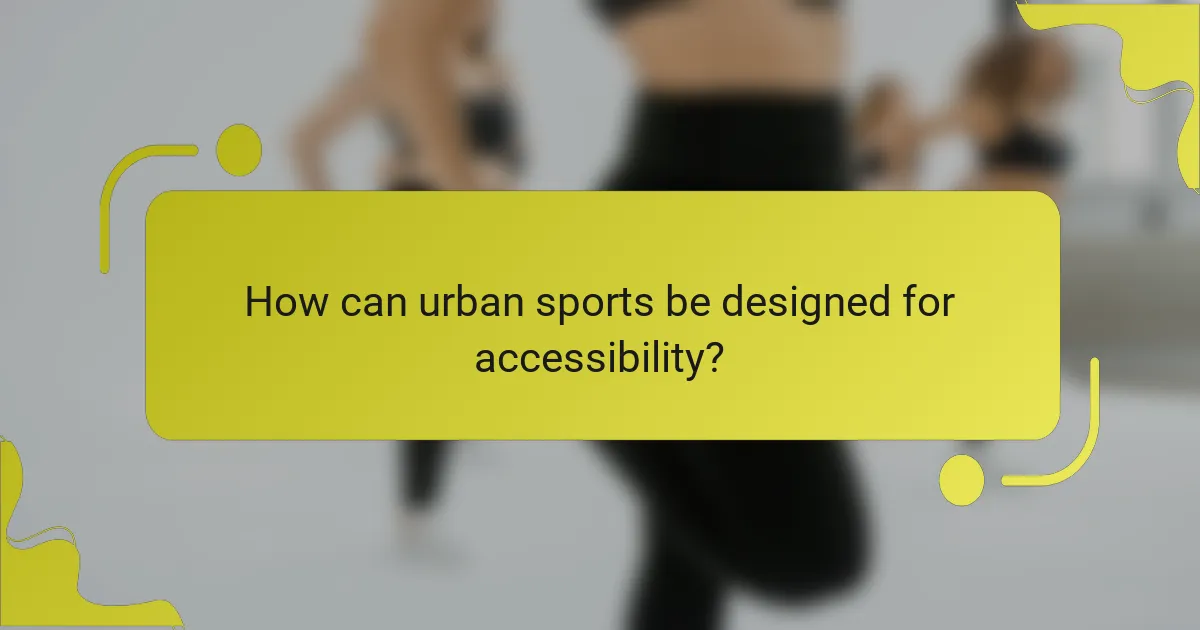
How can urban sports be designed for accessibility?
Urban sports can be designed for accessibility by incorporating adaptive equipment and inclusive facilities. Prioritising universal design principles ensures that spaces accommodate diverse abilities. Engaging local communities in the planning process fosters social inclusion and identifies specific needs. Implementing training programmes for coaches enhances support for participants with disabilities.
What are the key features of inclusive urban sports facilities?
Inclusive urban sports facilities prioritise accessibility, adaptability, and community engagement. Key features include wheelchair-accessible designs, adaptive sports equipment, diverse programme offerings, and inclusive spaces for social interaction. These attributes foster participation among individuals of all abilities, promoting social inclusion through sports.
Which technologies improve accessibility in adaptive sports?
Technologies such as adaptive equipment, mobile apps, and virtual reality enhance accessibility in adaptive sports. Adaptive equipment includes specialised wheelchairs and prosthetics, which enable participation. Mobile apps offer real-time information on accessible facilities and events. Virtual reality provides immersive training experiences, allowing athletes to practice in safe environments. These innovations support social inclusion and improve overall engagement in urban sports programmes.

What are the unique challenges faced by adaptive sports programmes?
Adaptive sports programmes face unique challenges including funding limitations, accessibility issues, and lack of awareness. These hurdles hinder participation and sustainability. Programmes often struggle to secure financial support, impacting their ability to provide necessary resources. Accessibility remains a critical concern, as facilities may not accommodate all disabilities. Additionally, public awareness of adaptive sports is often low, affecting recruitment and community engagement. Addressing these challenges is essential for promoting social inclusion through adaptive sports.
How do funding and resources impact programme sustainability?
Funding and resources significantly enhance programme sustainability by ensuring consistent support for adaptive sports initiatives. Adequate financial backing allows for the development of facilities, recruitment of qualified personnel, and provision of necessary equipment. Additionally, resources facilitate outreach efforts, promoting social inclusion and engagement within communities. Programmes that secure diverse funding sources, such as grants and partnerships, demonstrate greater resilience and adaptability, ultimately leading to long-term success and impact.
What barriers exist for participation in adaptive sports?
Barriers to participation in adaptive sports include limited access to facilities, inadequate funding, and lack of awareness. Physical disabilities can restrict mobility, while societal attitudes may discourage involvement. Additionally, insufficient training for coaches and volunteers hinders programme effectiveness. These factors collectively limit the inclusivity of adaptive sports programmes.
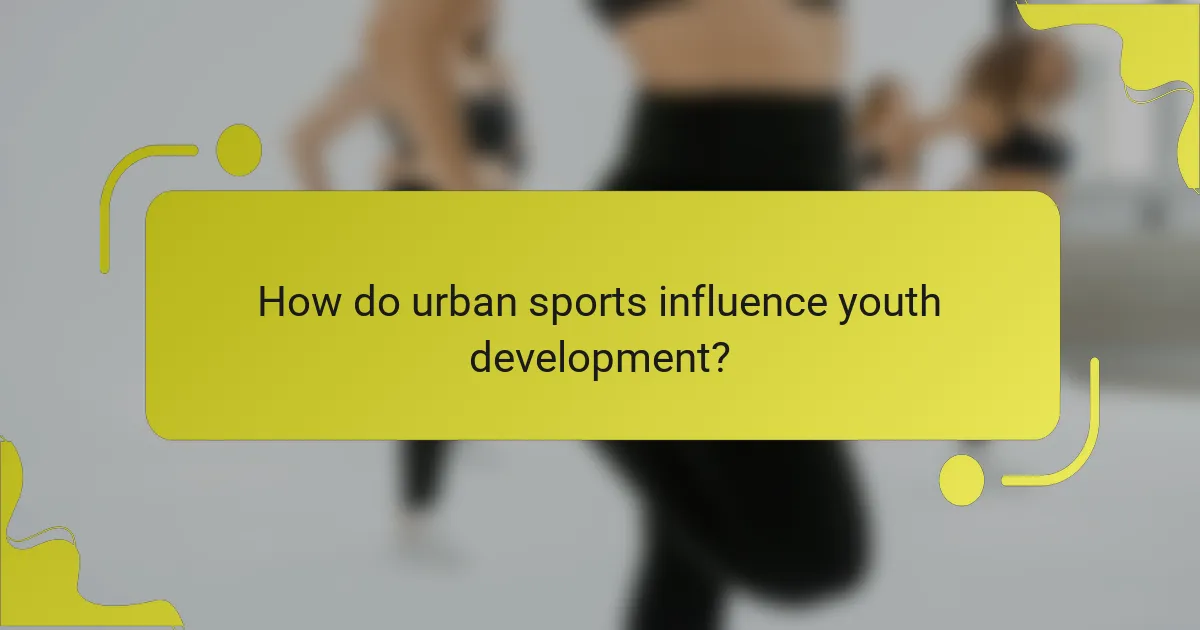
How do urban sports influence youth development?
Urban sports significantly influence youth development by promoting social inclusion and providing adaptive sports programmes. These programmes foster teamwork, resilience, and community engagement among young participants.
Urban sports encourage physical activity, which is essential for mental and physical health. Studies show that youth involved in such activities experience improved self-esteem and social skills.
Moreover, adaptive sports programmes create opportunities for individuals with disabilities, ensuring everyone can participate. This inclusivity helps break down social barriers and fosters a sense of belonging.
As a result, urban sports serve as a powerful tool for youth development, shaping well-rounded individuals who contribute positively to their communities.
What skills do participants gain from adaptive sports programmes?
Participants in adaptive sports programmes gain skills such as teamwork, resilience, and improved physical fitness. These programmes foster social inclusion, enhancing communication abilities and self-confidence. Participants often develop problem-solving skills through adaptive challenges, promoting independence and personal growth. Additionally, they learn to set and achieve personal goals, contributing to overall well-being.
Which success stories highlight the impact of urban sports on youth?
Urban sports significantly enhance youth engagement and social inclusion through adaptive sports programmes. Success stories include programmes that integrate diverse communities, fostering teamwork and resilience. For instance, the “Skateboarding for All” initiative in urban areas has empowered underprivileged youth, promoting physical health and social cohesion. Additionally, cities like Barcelona have reported increased youth participation in sports, leading to improved mental well-being and community ties. These initiatives highlight urban sports as a powerful tool for positive youth development and social change.

What metrics are used to evaluate the success of adaptive sports programmes?
Adaptive sports programmes are evaluated using metrics such as participant engagement, skill development, and community impact. These metrics assess social inclusion and the effectiveness of programme delivery.
| Metric | Description | Value |
|—————————-|——————————————————|—————————-|
| Participant Engagement | Number of active participants and retention rates | 75% retention over 6 months|
| Skill Development | Improvement in participant skills and confidence | 80% report increased skills |
| Community Impact | Feedback from local communities and partnerships | 90% positive community feedback |
| Accessibility | Availability of facilities and resources | 100% compliant facilities |
| Health Outcomes | Physical and mental health improvements | 70% report improved health |
| Programme Sustainability | Funding stability and resource allocation | 5-year funding secured |
How is participant satisfaction measured in urban sports?
Participant satisfaction in urban sports is measured through surveys, feedback forms, and observational studies. These methods assess engagement, enjoyment, and perceived benefits of adaptive sports programmes. Metrics like participation rates and retention also reflect satisfaction levels. Unique attributes such as community integration and accessibility further enhance the evaluation process.
What impact do adaptive sports have on community health outcomes?
Adaptive sports significantly enhance community health outcomes by promoting physical activity, social inclusion, and mental well-being. These programmes foster connections among participants, reducing isolation and improving overall quality of life. Research shows that individuals engaged in adaptive sports report higher levels of physical fitness and mental resilience. Additionally, communities benefit from increased awareness and support for inclusivity, leading to healthier environments.

Which trends are shaping the future of urban sports and sustainability?
Urban sports are increasingly integrating sustainability and social inclusion through adaptive sports programmes. These trends enhance accessibility, promote community engagement, and reduce environmental impact.
Adaptive sports programmes focus on inclusivity, allowing individuals with disabilities to participate in urban sports, fostering a sense of belonging. This approach supports social cohesion and encourages diverse participation across demographics.
Sustainability in urban sports emphasises eco-friendly infrastructure and practices. For example, the use of recycled materials for sports facilities and promoting public transport to events reduces carbon footprints.
Emerging technologies, like apps for tracking environmental impact, also contribute to these trends. They enable participants to engage with sustainability metrics, enhancing awareness and encouraging responsible practices within urban sports communities.
How are digital platforms changing the landscape of adaptive sports?
Digital platforms are revolutionising adaptive sports by enhancing accessibility and promoting social inclusion. They facilitate connections between athletes, coaches, and organisations, fostering community engagement. For instance, virtual training sessions allow individuals with disabilities to participate regardless of location. Additionally, social media campaigns raise awareness and encourage support for adaptive sports programmes. These platforms also provide resources and information, empowering athletes to pursue their goals. As a result, urban sports initiatives increasingly integrate sustainability and inclusivity, transforming local communities.
What innovative approaches are emerging in adaptive sports programming?
Innovative approaches in adaptive sports programming focus on inclusivity and sustainability. Programmes are integrating urban environments to enhance accessibility. Community engagement fosters social connections among diverse participants. Technology, such as adaptive equipment and virtual reality, enhances training experiences. Collaboration with local organisations promotes resource sharing and outreach. Data-driven insights help tailor programmes to meet the specific needs of participants.
What best practices can enhance the effectiveness of adaptive sports initiatives?
Implementing best practices enhances the effectiveness of adaptive sports initiatives through community engagement, accessibility, and tailored programming.
Engage local communities by involving individuals with disabilities in the planning process. This ensures programmes meet their specific needs and preferences.
Ensure facilities and equipment are accessible to all participants. This includes adaptive gear and spaces that accommodate various mobility challenges.
Tailor programmes to address the unique interests and abilities of participants. Offering diverse sports options encourages broader participation and fosters a sense of belonging.
Provide training for coaches and volunteers on adaptive techniques. This builds a knowledgeable support network that enhances participant experience and safety.
